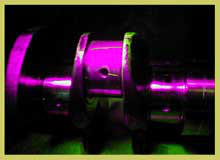Longitudinal cracks
from oil gallery and to
radius
Cracks detected under
ultra-violet light
























Crankshaft engine problem Brisbane - CRACKED
Crankshafts are under stress and vibration by their very nature of design. Some crankshafts crack more frequently than others. The most common cracks appear in the crankshafts out of the oil holes and in the radius areas. Some minor cracks can be removed when grinding to an under-size. Shafts that are prone to cracking should be crack tested before and after grinding. Some causes of cracks can be a faulty harmonic balancer, revving the engine above manufacturer specifications or out of balance shaft and associated components. As a common rule all diesel shafts should be crack- tested at time of engine overhaul. Crankshafts will crack in the radius area as a result of incorrect grinding. If the correct radius is reduced or the grinder produces a step edge this crank will be more likely to crack and become unserviceable than one ground correctly. Great care has to be taken to ensure no scratches or marks are evident in the radius area. Oil holes have to be re-chamfered after grinding and all burrs removed. Caution has to be taken to retain the correct size and chamfer. This area is very thin due to the angle of the oil drilling and will crack if not reshaped correctly after grinding. The reduction of vibration by balancing engine components will reduce the likelihood of crankshaft cracks. Shot peening and rolling of the radius area will also strengthen these areas against increased stress produced in high performance diesel's and racing engines. Disclaimer Agreement : Every care has been taken in writing this information and procedures, but no responsibility can be excepted for errors, omissions or misuse of this information and procedures. The information available on this site is for your instruction only and cannot be copied for sale, © copyright 2001 UMR Engines






















•
Queensland Transport Authorised to approve LA1,LA3,LB1,LD1-2,LK1,LK6 Modification’s to light vehicles
•
LPG Approved Workshop
•
RWC Licence
•
RACQ Approved Automotive Repairer

Longitudinal cracks
from oil gallery and to
radius
Cracks detected under
ultra-violet light




Crankshaft engine problem Brisbane -
CRACKED
Crankshafts are under stress and vibration by their very nature of design. Some crankshafts crack more frequently than others. The most common cracks appear in the crankshafts out of the oil holes and in the radius areas. Some minor cracks can be removed when grinding to an under-size. Shafts that are prone to cracking should be crack tested before and after grinding. Some causes of cracks can be a faulty harmonic balancer, revving the engine above manufacturer specifications or out of balance shaft and associated components. As a common rule all diesel shafts should be crack-tested at time of engine overhaul. Crankshafts will crack in the radius area as a result of incorrect grinding. If the correct radius is reduced or the grinder produces a step edge this crank will be more likely to crack and become unserviceable than one ground correctly. Great care has to be taken to ensure no scratches or marks are evident in the radius area. Oil holes have to be re-chamfered after grinding and all burrs removed. Caution has to be taken to retain the correct size and chamfer. This area is very thin due to the angle of the oil drilling and will crack if not reshaped correctly after grinding. The reduction of vibration by balancing engine components will reduce the likelihood of crankshaft cracks. Shot peening and rolling of the radius area will also strengthen these areas against increased stress produced in high performance diesel's and racing engines. Disclaimer Agreement : Every care has been taken in writing this information and procedures, but no responsibility can be excepted for errors, omissions or misuse of this information and procedures. The information available on this site is for your instruction only and cannot be copied for sale, © copyright 2001 UMR Engines





7 Moss Street, Slacks Creek, Qld 4127


































